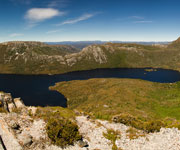Covering an area of over 1 million hectares, the Tasmanian Wilderness constitutes one of the last expanses of temperate rainforest in the world. It comprises a contiguous network of reserved lands that extends over much of south-western Tasmania including several coastal islands. In contrast to the mainland, the island of Tasmania is a rugged region with fold structures in the western half and fault structures in the east, both of which are represented in the property. The fold structure province in the south-west is an extremely rugged and densely vegetated region with north-south oriented mountain ranges and valley systems.

Continent: Oceania
Country: Australia
Category: Mixed Heritage Site
Criterion: (III)(IV) (VI) (VII) (VIII) (IX) (X)
Date of Inscription: 1982
Tasmanian Wilderness Atmosphere
Changing climates have also influenced landscape development, highlighted most recently by late Cainozoic and Pleistocene glacial and periglacial events. Glacial erosion has contributed to spectacular landform features including horns, aretes, cirques, U-shaped valleys and rock basins (tarns). The coastline has been subjected to a number of sea-level changes during the glaciations and now provides a classic example of a drowned landscape, as shown by the discordant coastline in the south. Special landforms associated with the development of karst have formed through the solution of carbonate rocks such as (Precambrian) dolomite and (Ordovician) limestone. Features include cave systems, natural arches, clints and grikes, dolines, karren, pinnacles and blind valleys.The vegetation has as much in common with cool, temperate regions of South America and New Zealand as with the rest of Australia. In addition to climatic and edaphic factors, the vegetation has developed in response to fire. Aboriginal occupation over the last 30,000 years has constituted a major source of fire; more recently, much fire can be attributed to the interests of fishermen, logging concerns and prospectors. The fauna is of world importance because it includes an unusually high proportion of endemic species and relict groups of ancient lineage. Owing to the diverse topography, geology, soils and vegetation in association with harsh and variable climatic conditions combining to create a wide array of animal habitats, the fauna is correspondingly diverse.










No comments:
Post a Comment